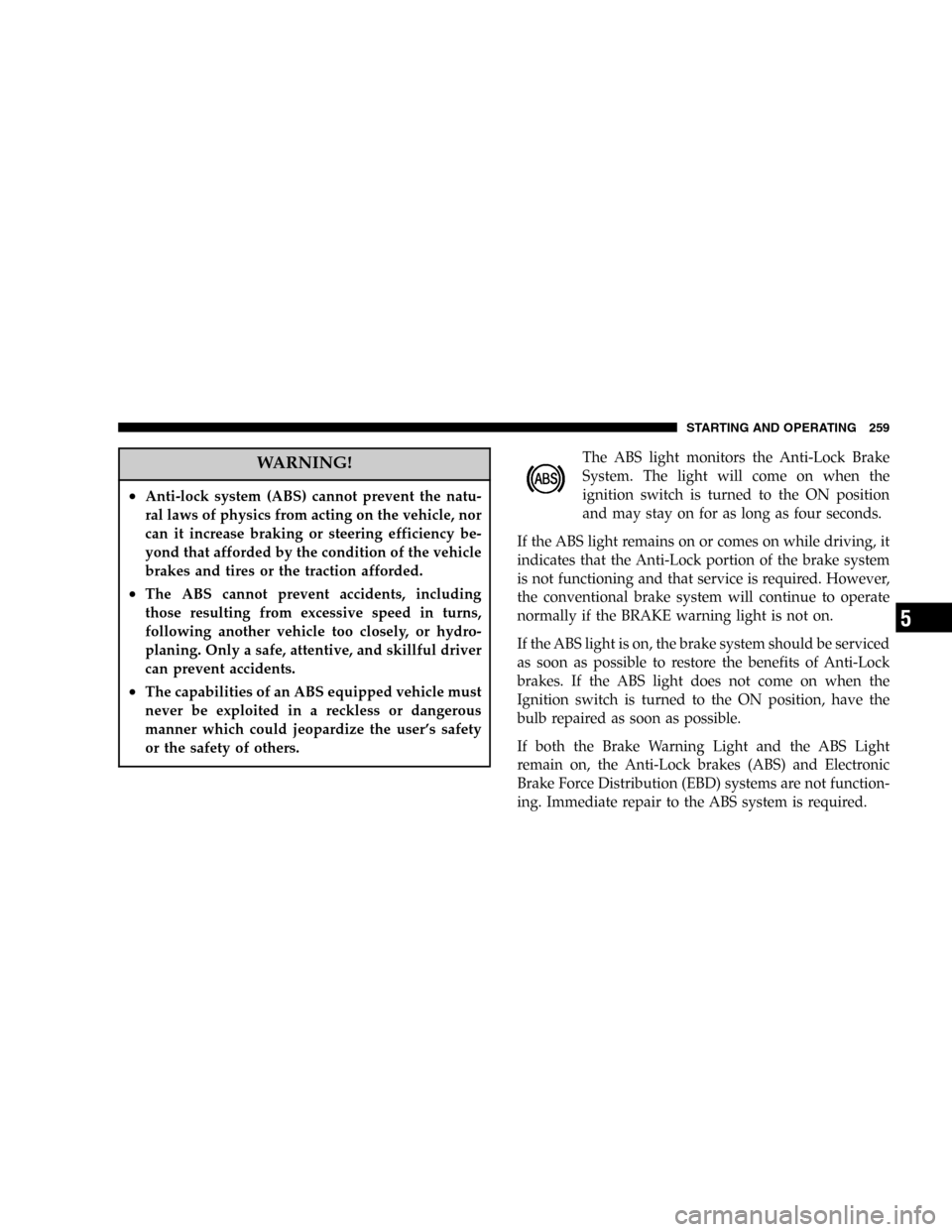Page 69 of 420

Airbag Light
The light should come on and remain on for 6
to 8 seconds as a bulb check when the ignition
switch is first turned ON. If the LED is not lit
during starting, have it checked. If the light
stays on or comes on while driving, have the system
checked by an authorized dealer.
Defroster
Check operation by selecting the defrost mode and place
the blower control on high speed. You should be able to
feel the air directed against the windshield.
Periodic Safety Checks You Should Make Outside
The Vehicle
Tires
Examine tires for excessive tread wear or uneven wear
patterns. Check for stones, nails, glass, or other objectslodged in the tread. Inspect tread and sidewall for cuts or
cracks. Check wheel nuts for tightness, and tires (includ-
ing spare) for proper pressure.
Lights
Have someone observe the operation of exterior lights
while you work the controls. Check turn signal and high
beam indicator lights on the instrument panel.
Fluid Leaks
Check area under vehicle after overnight parking for fuel,
engine coolant, oil or other fluid leaks. Also, if gasoline
fumes are detected or fuel, power steering fluid or brake
fluid leaks are suspected, the cause should be located and
corrected immediately.
THINGS TO KNOW BEFORE STARTING YOUR VEHICLE 69
2
Page 172 of 420

21. Tire Pressure Monitor Warning Light—If
Equipped
This light will turn on when there is a Low tire
pressure condition. The light will remain on
until the tire pressure is properly set. The light
will also flash if a problem exist with any tire
sensor. The light will flash for approximately three sec-
onds every 10 minutes or until the problem with the
sensor is corrected.
This light will turn on momentarily as a bulb check when
the engine is started.
When the tire pressure monitoring system warning light
is lit, one or more of your tires is significantly underin-
flated. You should stop and check your tires as soon as
possible, and inflate them to the proper pressure as
indicated on the tire and loading information placard.
Driving on a significantly underinflated tire causes thetire to overheat and can lead to tire failure. Underinfla-
tion also reduces fuel efficiency and tire tread life, and
may affect the vehicle’s handling and stopping ability.
Each tire, including the spare, should be checked
monthly when cold and set to the recommended inflation
pressure as specified in the tire and loading information
placard and owner’s manual.
NOTE:If one of the vehicle active tires has been
replaced by the spare or a wheel rim not equipped with
a TPM sensor, the tire pressure monitor warning light
will flash for approximately three seconds every 10
minutes. Repair or replace the tire or sensor as soon as
possible.
172 UNDERSTANDING YOUR INSTRUMENT PANEL
Page 246 of 420

▫Tire Markings........................263
▫Tire Identification Number (TIN)..........267
▫Tire Loading And Tire Pressure...........268
�Ti re s—General Information................272
▫Tire Pressure.........................272
▫Tire Inflation Pressures.................273
▫Radial-Ply Tires......................276
▫Compact Spare Tire—If Equipped.........276
▫Limited Use Spare—If Equipped.........277
▫Tire Spinning........................278
▫Tread Wear Indicators..................278
▫Replacement Tires.....................279
▫Alignment And Balance.................280�All Wheel Drive (AWD)—If Equipped.......281
�Tire Pressure Monitor System—If Equipped . . . 281
▫1,2,3, Or 4 Tire(s) Low Pressure...........282
▫1,2,3, Or 4 Tire(s) High Pressure...........282
▫Service Tire Pressure System/See Owner’s
Manual............................282
▫General Information...................284
�Tire Chains...........................284
�Snow Tires...........................285
�Tire Rotation Recommendations............286
�Fuel Requirements......................287
▫Reformulated Gasoline.................287
▫Gasoline/Oxygenate Blends..............288
246 STARTING AND OPERATING
Page 256 of 420
CAUTION!
All wheels must have the same size and type tires.
Unequal tire sizes must not be used. Unequal tire
size may cause failure of the power transfer unit
and/or the viscous coupling.
PARKING BRAKE
When the parking brake is applied with the ignition
switch on, the brake light in the instrument cluster will
turn on.
NOTE:This light only shows that the parking brake is
applied. It does not show the degree of brake application.Before leaving the vehicle, make sure that the parking
brake is fully applied and place the gear selector in the
Park position. To release the parking brake, pull out on
the parking brake release located on the left side of the
instrument panel.
Parking Brake Release
256 STARTING AND OPERATING
Page 259 of 420

WARNING!
•Anti-lock system (ABS) cannot prevent the natu-
ral laws of physics from acting on the vehicle, nor
can it increase braking or steering efficiency be-
yond that afforded by the condition of the vehicle
brakes and tires or the traction afforded.
•The ABS cannot prevent accidents, including
those resulting from excessive speed in turns,
following another vehicle too closely, or hydro-
planing. Only a safe, attentive, and skillful driver
can prevent accidents.
•The capabilities of an ABS equipped vehicle must
never be exploited in a reckless or dangerous
manner which could jeopardize the user’s safety
or the safety of others.
The ABS light monitors the Anti-Lock Brake
System. The light will come on when the
ignition switch is turned to the ON position
and may stay on for as long as four seconds.
If the ABS light remains on or comes on while driving, it
indicates that the Anti-Lock portion of the brake system
is not functioning and that service is required. However,
the conventional brake system will continue to operate
normally if the BRAKE warning light is not on.
If the ABS light is on, the brake system should be serviced
as soon as possible to restore the benefits of Anti-Lock
brakes. If the ABS light does not come on when the
Ignition switch is turned to the ON position, have the
bulb repaired as soon as possible.
If both the Brake Warning Light and the ABS Light
remain on, the Anti-Lock brakes (ABS) and Electronic
Brake Force Distribution (EBD) systems are not function-
ing. Immediate repair to the ABS system is required.
STARTING AND OPERATING 259
5
Page 260 of 420

When the vehicle is driven over 7 mph (11 km/h), you
may also hear a slight clicking sound as well as some
related motor noises. These noises are the system per-
forming its self check cycle to ensure that the ABS system
is working properly. This self check occurs each time the
vehicle is started and accelerated past 7 mph (11 km/h).
ABS is activated during braking under certain road or
stopping conditions. ABS-inducing conditions can in-
clude ice, snow, gravel, bumps, railroad tracks, loose
debris, or panic stops.
You also may experience the following when the brake
system goes into Anti-lock:
•The ABS motor running (it may continue to run for a
short time after the stop),
•the clicking sound of solenoid valves,
•brake pedal pulsations,
•and a slight drop or fall away of the brake pedal at the
end of the stop.
These are all normal characteristics of ABS.
WARNING!
The Anti-Lock Brake System contains sophisticated
electronic equipment that may be susceptible to
interference caused by improperly installed or high
output radio transmitting equipment. This interfer-
ence can cause possible loss of anti-lock braking
capability. Installation of such equipment should be
performed by qualified professionals.
All vehicle wheels and tires must be the same size and
type and tires must be properly inflated to produce
accurate signals for the computer.
260 STARTING AND OPERATING
Page 263 of 420
NOTE:
•The Traction Control system will make buzzing or
clicking sounds when in operation.
•Extended heavy use of Traction Control may cause the
system to deactivate and turn on the traction control
indicator located in the instrument cluster.
This is to prevent overheating of the brake system and
is a normal condition. The system will remain disabled
for about 4 minutes until the brakes have cooled. The
system will automatically reactivate and turn off the
traction control indicator.
•If your vehicle becomes stuck in mud, ice, or snow,
turn the Traction Control System OFF before at-
tempting to“rock”the vehicle free.
TIRE SAFETY INFORMATION
Tire Markings
NOTE:
•P(Passenger)-Metric tire sizing is based on U.S. design
standards. P-Metric tires have the letter“P”molded
into the sidewall preceding the size designation. Ex-
ample: P215/65R15 95H.
STARTING AND OPERATING 263
5
Page 264 of 420
•European Metric tire sizing is based on European
design standards. Tires designed to this standard have
the tire size molded into the sidewall beginning with
the section width. The letter�P�is absent from this tire
size designation. Example: 215/65R15 96H
•LT(Light Truck)-Metric tire sizing is based on U.S.
design standards. The size designation for LT-Metric
tires is the same as for P-Metric tires except for the
letters“LT”that are molded into the sidewall preced-
ing the size designation. Example: LT235/85R16.
•Temporary Spare tires are high pressure compact
spares designed for temporary emergency use only.
Tires designed to this standard have the letter“T”
molded into the sidewall preceding the size designa-
tion. Example: T145/80D18 103M.
•High Flotation tire sizing is based on U.S. design
standards and begins with the tire diameter molded
into the sidewall. Example: 31x10.5 R15 LT.
264 STARTING AND OPERATING